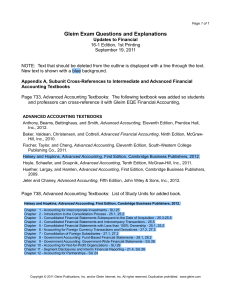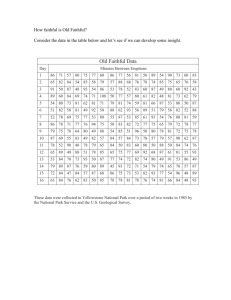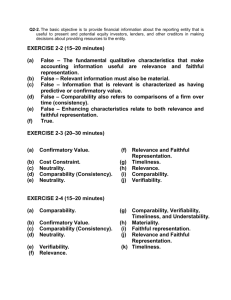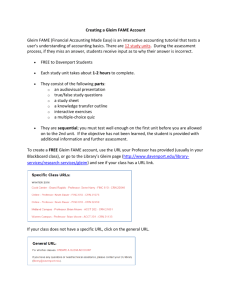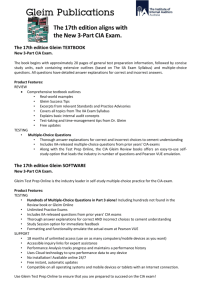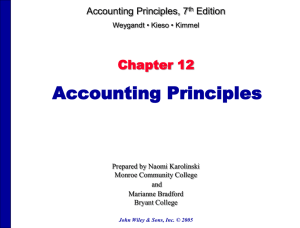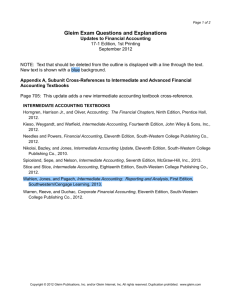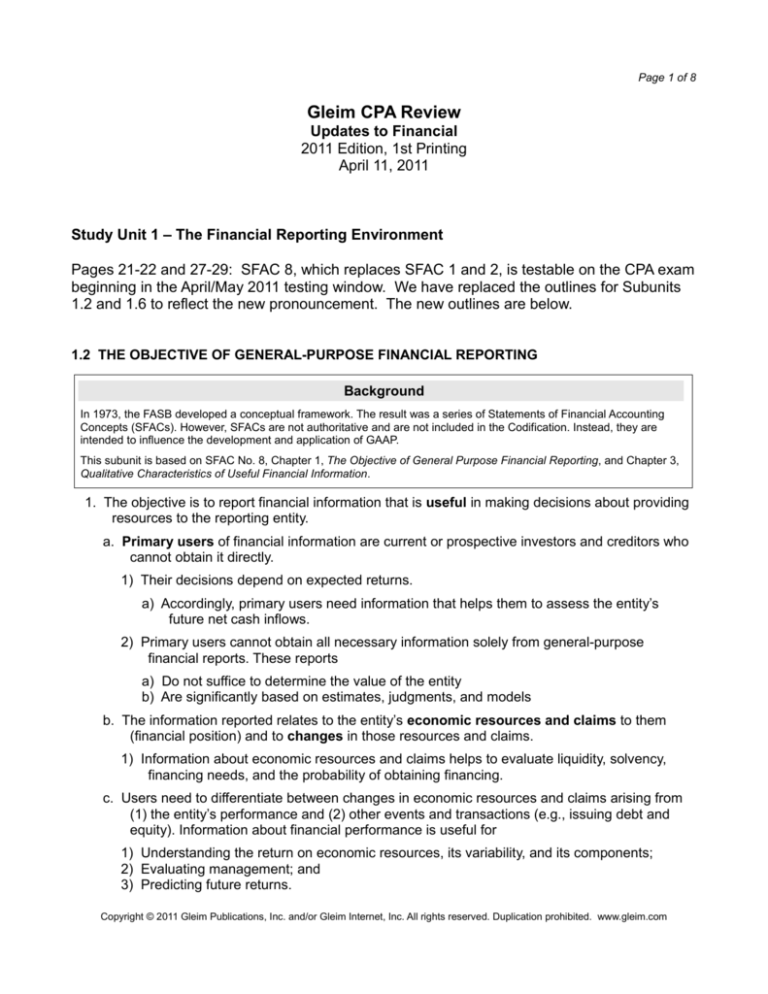
Page 1 of 8
Gleim CPA Review
Updates to Financial
2011 Edition, 1st Printing
April 11, 2011
Study Unit 1 – The Financial Reporting Environment
Pages 21-22 and 27-29: SFAC 8, which replaces SFAC 1 and 2, is testable on the CPA exam
beginning in the April/May 2011 testing window. We have replaced the outlines for Subunits
1.2 and 1.6 to reflect the new pronouncement. The new outlines are below.
1.2 THE OBJECTIVE OF GENERAL-PURPOSE FINANCIAL REPORTING
Background
In 1973, the FASB developed a conceptual framework. The result was a series of Statements of Financial Accounting
Concepts (SFACs). However, SFACs are not authoritative and are not included in the Codification. Instead, they are
intended to influence the development and application of GAAP.
This subunit is based on SFAC No. 8, Chapter 1, The Objective of General Purpose Financial Reporting, and Chapter 3,
Qualitative Characteristics of Useful Financial Information.
1. The objective is to report financial information that is useful in making decisions about providing
resources to the reporting entity.
a. Primary users of financial information are current or prospective investors and creditors who
cannot obtain it directly.
1) Their decisions depend on expected returns.
a) Accordingly, primary users need information that helps them to assess the entity’s
future net cash inflows.
2) Primary users cannot obtain all necessary information solely from general-purpose
financial reports. These reports
a) Do not suffice to determine the value of the entity
b) Are significantly based on estimates, judgments, and models
b. The information reported relates to the entity’s economic resources and claims to them
(financial position) and to changes in those resources and claims.
1) Information about economic resources and claims helps to evaluate liquidity, solvency,
financing needs, and the probability of obtaining financing.
c. Users need to differentiate between changes in economic resources and claims arising from
(1) the entity’s performance and (2) other events and transactions (e.g., issuing debt and
equity). Information about financial performance is useful for
1) Understanding the return on economic resources, its variability, and its components;
2) Evaluating management; and
3) Predicting future returns.
Copyright © 2011 Gleim Publications, Inc. and/or Gleim Internet, Inc. All rights reserved. Duplication prohibited. www.gleim.com
Page 2 of 8
d. The accrual basis of accounting is preferable to the cash basis for evaluating past
performance and predicting future performance.
1) An entity should increase its economic resources other than by obtaining resources
from investors and creditors.
a) Information about this performance is useful in evaluating potential operating net cash
inflows.
2) Information about financial performance is useful in determining how external factors (e.g.,
interest rate changes) affected economic resources and claims.
e. Information about cash flows is helpful in
1)
2)
3)
4)
Understanding operations;
Evaluating financing and investing activities, liquidity, and solvency;
Interpreting other financial information; and
Assessing the potential for net cash inflows.
Stop and review! You have completed the outline for this subunit. Study multiple-choice
questions 5 through 8 beginning on page 40.
1.6 QUALITATIVE CHARACTERISTICS OF USEFUL FINANCIAL INFORMATION
Background
The characteristics described in this subunit are those that make accounting information useful for decision making. They
apply to both for-profit and not-for-profit nongovernmental entities.
This subunit is based on SFAC No. 8.
Fundamental Qualitative Characteristics
1. Relevance. Relevant information is able to make a difference in user decisions. To do so, it must
have predictive value, confirmatory value, or both.
a. Something has predictive value if it can be used as an input in a predictive process.
b. Something has confirmatory value with respect to prior evaluations if it provides feedback that
confirms or changes (corrects) them.
c. Predictive value and confirmatory value are interrelated. For example, current revenue may
confirm a prior prediction and also be used to predict the next period’s revenue.
d. Materiality. Information is material if its omission or misstatement can influence user
decisions based on a specific entity’s financial information. Thus, it is an entity-specific
aspect of relevance.
2. Faithful representation. Useful information faithfully represents the economic phenomena that it
purports to represent. A representation is perfectly faithful if it is complete (containing what is
needed for user understanding), neutral (unbiased in its selection and presentation), and free
from error (but not necessarily perfectly accurate).
Copyright © 2011 Gleim Publications, Inc. and/or Gleim Internet, Inc. All rights reserved. Duplication prohibited. www.gleim.com
Page 3 of 8
3. Useful information is relevant and faithfully represented. The process for applying these
characteristics is to
a. Identify a phenomenon that may be useful to users,
b. Identify the relevant information, and
c. Determine whether the information is available and can be faithfully represented.
Enhancing Qualitative Characteristics
4. The following enhance the usefulness of relevant and faithfully represented information:
a. Comparability. Information should be comparable with similar information for (1) other
entities and (2) the same entity for another period or date. Thus, comparability allows users
to understand similarities and differences.
1) Consistency is a means of achieving comparability. It is the use of the same methods, for
example, accounting principles, for the same items.
b. Verifiability. Information is verifiable (directly or indirectly) if knowledgeable and independent
observers can reach a consensus (but not necessarily unanimity) that it is faithfully
represented.
c. Timeliness. Information is timely when it is available in time to influence decisions.
d. Understandability. Understandable information is clearly and concisely classified,
characterized, and presented.
1) Information should be readily understandable by reasonably knowledgeable and diligent
users, but information should not be excluded because of its complexity.
Do not confuse the fundamental qualitative characteristics and the enhancing characteristics. Also, be
aware of the aspects of each fundamental characteristic.
Cost Constraint
5. This pervasive constraint is that the costs of reporting should be justified by its benefits.
a. Provider costs (collection, processing, verification, and distribution) ultimately are incurred by
users as reduced returns.
b. Other user costs include those to analyze and interpret the information provided or to obtain
or estimate information not provided.
Copyright © 2011 Gleim Publications, Inc. and/or Gleim Internet, Inc. All rights reserved. Duplication prohibited. www.gleim.com
Page 4 of 8
Figure 1-1
Stop and review! You have completed the outline for this subunit. Study multiple-choice
questions 22 through 25 beginning on page 45.
Page 40, Subunit 1.2, Question 5: The following question has been rewritten to reflect the
new SFAC 8. Replace current question 5 in your book with this one.
5. According to the FASB’s conceptual framework, the
objectives of general-purpose financial reporting for
business enterprises are is most likely based on
A. Generally accepted accounting principles.
B. Reporting on how well management’s stewardship
has discharged its responsibilities.
C. The need for conservatism.
D. The needs of the users of the information.
Answer (D) is correct. (CPA, adapted)
REQUIRED: The objectives of financial reporting for
business enterprises.
DISCUSSION: One The objective of general-purpose
financial reporting is to provide information that is useful to
present existing and potential investors, creditors lenders, and
other users creditors in making rational investment, credit, and
similar decisions about providing resources to the entity.
Answer (A) is incorrect. GAAP govern how to account for
items in the financial statements. Answer (B) is incorrect.
Financial reporting provides information that is helpful, among
other things, in evaluating how well management’s
stewardship but does not directly provide information about
that performance has discharged its responsibilities to make
effective and efficient use of entity resources. But it is the
basis for general-purpose financial reporting. Answer (C) is
incorrect. Conservatism is a qualitative characteristic
constraint on recognition in the statements. It is a response
uncertainty.
Copyright © 2011 Gleim Publications, Inc. and/or Gleim Internet, Inc. All rights reserved. Duplication prohibited. www.gleim.com
Page 5 of 8
Pages 45 and 46, Subunit 1.6, Questions 22 through 25: The following questions have been
rewritten to reflect the new SFAC 8. Replace current questions 22-25 in your book with these.
22. According to Statements of Financial Accounting
Concepts, predictive value relates to
Relevance
Faithful
Reliability Representation
A.
No
No
B.
Yes
Yes
C.
No
Yes
D.
Yes
No
23. According to the FASB’s conceptual framework, what
does the concept of reliability faithful representation in
financial reporting include?
A. Effectiveness Predictive value.
B. Certainty.
C. Precision Perfectly accurate.
D. Neutrality.
Answer (D) is correct. (CPA, adapted)
REQUIRED: The primary quality of which predictive value
is an ingredient.
DISCUSSION: The primary quality of relevance is the
Relevance is a fundamental qualitative characteristic of useful
financial information. It is the capacity of information to make a
difference in a decision. It is composed of must have (1)
predictive value, (2) feedback value, and (3) timeliness
confirmatory value, or both. Predictive value is the quality of
information that helps users increase the likelihood of correctly
forecasting the outcome of past and present events. The
ingredients of reliability are verifiability, neutrality, and
representational faithfulness. Moreover, materiality is an
entity-specific aspect of relevance. Information has predictive
value if it can be used in a predictive process. Something has
confirmatory value with respect to prior evaluations if it
provides feedback that confirms or changes (corrects) them.
Answer (D) is correct. (CPA, adapted)
REQUIRED: The item included in the concept of reliability
faithful representation.
DISCUSSION: Reliability and relevance are the primary
decision-specific qualitative characteristics of accounting
information. Reliable information is “reasonably free from error
and bias and faithfully represents what it purports to
represent.” Reliability includes the ingredients of
representational faithfulness and verifiability and the
secondary and interactive quality of neutrality. Neutrality is
“absence in reported information of bias intended to attain a
predetermined result or to induce a particular mode of
behavior.” Faithful representation and relevance are the
fundamental qualitative characteristics of accounting
information. A perfectly faithful representation is complete,
neutral, and free from error. Faithfully represented information
is neutral if it is unbiased in its selection or presentation of
information.
Answer (A) is incorrect. Accounting information is effective
if it is relevant. Reliable information is not necessarily relevant.
Relevant information has predictive value, confirmatory value,
or both. Faithfully represented information is not necessarily
relevant. Answer (B) is incorrect. Certainty and precision
perfect accuracy are not implied by reliability faithful
representation. The financial statements are a model of the
reporting entity. This model may be representationally faithful
for its intended purposes without corresponding precisely to
the real-world original. Thus, uncertainty that does not reach
the materiality threshold does not impair reliability faithful
representation. Answer (C) is incorrect. Information may be
reliable within materiality limits but lack precision represented
faithfully, that is, complete, neutral, and free from error, without
being perfectly accurate.
Copyright © 2011 Gleim Publications, Inc. and/or Gleim Internet, Inc. All rights reserved. Duplication prohibited. www.gleim.com
Page 6 of 8
24. According to the FASB’s conceptual framework, the
usefulness of providing information in financial statements
is subject to the constraint of
A. Consistency.
B. Cost-benefit.
C. Reliability Relevance.
D. Representational faithfulness.
25. According to the FASB’s conceptual framework, which
of the following situations most likely does not violates the
concept of reliability faithful representation?
A. Financial statements were issued 9 months late.
B. Report data on segments having the same expected
risks and growth rates to analysts estimating future
profits.
C. Financial statements included property with a
carrying amount increased to management’s
estimate of market value.
D. Management reports to shareholders regularly refer
to new projects undertaken, but the financial
statements never report project results.
Answer (B) is correct. (CPA, adapted)
REQUIRED: The constraint on financial reporting.
DISCUSSION: The cCost-benefit principle is a pervasive
constraint on the information provided by financial reporting.
Financial information will not be sought unless its The benefits
of financial information should exceed the costs of reporting.
Answer (A) is incorrect. Consistency is a quality of useful
information, not constraints means of achieving comparability,
an enhancing qualitative characteristic. It is the use of the
same methods, for example, accounting principles, for the
same items. Answer (C) is incorrect. Reliability is a quality
Relevance is a fundamental qualitative characteristic of useful
information, not a constraints. Answer (D) is incorrect.
Representational faithfulness is a quality fundamental
qualitative characteristic of useful information, not a
constraints.
Answer (C B) is correct. (CPA, adapted)
REQUIRED: The violation of the concept of reliability
faithful representation.
DISCUSSION: The ingredients of reliability are
verifiability, neutrality, and representational faithfulness.
Verifiability is the “ability through consensus among measurers
to ensure that information represents what it purports to
represent or that the chosen method of measurement has
been used without error or bias.” Management’s estimate of
market value may not be verifiable because it may not reflect
a consensus and may be biased or in error. Useful
information faithfully represents the economic phenomena that
it purports to represent. A representation is perfectly faithful if it
is complete (containing what is needed for user understanding), neutral (unbiased in its selection or presentation),
and free from error (but not necessarily perfectly accurate).
The faithful representation of any given information is logically
unrelated to whether the segments have the same expected
risks and growth rates (assuming freedom from error) or the
identity of the users.
Answer (A) is incorrect. Late issuance is a matter of
timeliness, which is an ingredient of relevance, not reliability.
Timeliness is a qualitative characteristic that
enhances relevance and faithful representation. Information is
timely when it is available in time to influence decisions.
Answer (B C) is incorrect. The reliability of any given
information Is logically unrelated to the identity of the users.
Management’s estimate of market value may not be verifiable.
Verifiability is a qualitative characteristic that enhances
relevance and faithful representation. Information is verifiable
(directly or indirectly) if knowledgeable and independent
observers can reach a consensus (but not necessarily
unanimity) that it is faithfully represented. Answer (D) is
incorrect. Failure to report results is a matter of relevance, in
particular, timeliness. Timeliness is a qualitative characteristic
that enhances relevance and faithful representation.
Information is timely when it is available in time to influence
decisions.
Copyright © 2011 Gleim Publications, Inc. and/or Gleim Internet, Inc. All rights reserved. Duplication prohibited. www.gleim.com
Page 7 of 8
Page 54, Practice Simulation: Tab 2 was updated to reflect the new SFAC 8.
Select from the list provided the entity type of financial reporting to which each objective of financial reporting most
clearly applies. Each choice may be used once, more than once, or not at all.
Reporting Objective
Answer
1. Assessing management stewardship and performance
Entity Type
A) Business entities
General-purpose
financial reporting
2. Assessing services provided
3. Entity resources, claims to those resources, and changes
in them
B) Not-for-profit entities
4. Factors that may affect an organization’s liquidity
C) Governmental entities
5. Investment and credit decisions
6. Public accountability
Page 55, Practice Simulation: Tab 5 was updated to reflect the new SFAC 8.
Select from the list provided the appropriate description of each accounting concept below. Each choice may be used
once or more than once.
Concept
1. Benefits > costs
Answer
Description
2. Comparability
A) Interactive quality Enhancing qualitative
characteristic
3. Conservatism
B) Threshold for recognition
4. Consistency
C) Ingredient of rRelevance
5. Decision usefulness Relevance
D) User-specific quality Fundamental
qualitative characteristic
6. Economic entity
7. Feedback Confirmatory value
8. Full disclosure
E) Ingredient of reliability Faithful
representation
9. Going concern
F) Constraint
10. Historical cost
G) Assumption
11. Industry practices
H) Principle
Copyright © 2011 Gleim Publications, Inc. and/or Gleim Internet, Inc. All rights reserved. Duplication prohibited. www.gleim.com
Page 8 of 8
Page 56, Unofficial Answers, 2. Reporting Objectives: This update was made to reflect the
changes in Tab 2.
2. Reporting Objectives (6 Gradable Items)
1.
B) Not-for-profit entities. A reporting objective of not-for-profit (nongovernmental) entities is to provide information
useful in assessing management stewardship.
2.
C) Governmental entities. A reporting objective of governmental entities is to assist in assessing services provided.
3.
A) Business entities General-purpose financial reporting. A reporting The objective of business entities is to provide
general-purpose financial reporting is to report financial information that is useful in making decisions about providing
economic resources to the reporting entity. The information about relates to entity resources, claims to those
resources, and changes in them.
4.
B) Not-for-profit entities. A reporting objective of not-for-profit (nongovernmental) entities is to provide information
about factors that may affect an organization’s liquidity.
5.
A) Business entities General-purpose financial reporting. A reporting The objective of business entities is to provide
information useful in investment and credit decisions. general-purpose financial reporting is to report financial
information that is useful in making decisions about providing economic resources to the reporting entity. Primary
users are current and prospective investors and creditors.
6.
C) Governmental entities. A reporting objective of governmental entities is to assist in public accountability.
Page 58, Unofficial Answers, 5. Concepts II: This update was made to reflect the changes in
Tab 5.
5. Concepts II (11 Gradable Items)
1.
F) Constraint. Constraints are the following: cost-benefit, materiality, industry practice, and conservatism.
2.
A) Interactive quality Enhancing qualitative characteristic. Qualitative characteristics of accounting information
consist of user-specific qualities (understandability, decision usefulness), decision-specific qualities fundamental
characteristics (relevance, reliability, and faithful representation), and secondary and interactive qualities and
enhancing characteristics (comparability, consistency verifiability, timeliness, and understandability).
3.
F) Constraint. Constraints are the following: cost-benefit, materiality, industry practice, and conservatism.
4.
A) Interactive quality Enhancing qualitative characteristic. Qualitative characteristics of accounting information
consist of user-specific qualities (understandability, decision usefulness), decision-specific qualities (relevance,
reliability), and secondary and interactive qualities (comparability, consistency). fundamental characteristics
(relevance and faithful representation) and enhancing characteristics (comparability, verifiability, timeliness, and
understandability). Consistency is a means of achieving comparability.
5.
D) User-specific quality Fundamental qualitative characteristic. Qualitative characteristics of accounting information
consist of user-specific qualities (understandability, decision usefulness), decision-specific qualities (relevance,
reliability), and secondary and interactive qualities (comparability, consistency). fundamental characteristics
(relevance and faithful representation) and enhancing characteristics (comparability, verifiability, timeliness, and
understandability).
6.
G) Assumption. Assumptions are the following: economic entity, going concern, monetary unit, and periodicity.
7.
C) Ingredient of rRelevance. Primary decision-specific qualities Fundamental qualitative characteristics include
relevance and reliability faithful representation. Ingredients of relevance include feedback value, predictive value, and
timeliness. Ingredients of reliability include verifiability, neutrality, and representational faithfulness. Relevant
information has predictive value, confirmatory value, or both. Materiality is an entity-specific aspect of relevance.
8.
H) Principle. Principles are the following: historical cost, revenue recognition, matching, and full disclosure.
9.
G) Assumption. Assumptions are the following: economic entity, going concern, monetary unit, and periodicity.
10. H) Principle. Principles are the following: historical cost, revenue recognition, matching, and full disclosure.
11. F) Constraint. Constraints are the following: cost-benefit, materiality, industry practice, and conservatism.
Copyright © 2011 Gleim Publications, Inc. and/or Gleim Internet, Inc. All rights reserved. Duplication prohibited. www.gleim.com

